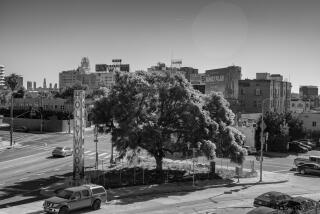<i> Diospyros kaki</i> Oriental or Japanese Persimmon : Deciduous ornamental fruit trees
- Share via
It is a sad and frustrating truth that most fruit trees are unattractively utilitarian, while the really beautiful trees--even those belonging to fruit families, such as flowering peach and plum--have nothing worth eating.
One of the prettiest exceptions is the persimmon. Reaching about 30 feet in height if left unchecked, persimmons are handsome enough in full leaf, but they really pay off in fall and winter: After the leaves drop, the deep, glowing orange fruit shines like jewels; when the fruit is gone, the tree’s naked branches are exposed in all their spreading glory. This is a great tree for kids to climb.
The leaves are large and leathery, not the best for close-up viewing, so a persimmon tree should be planted far enough from a patio to show off its structure and fruit without focusing too much attention on the individual leaves. The overall effect in autumn, though, when the leaves turn orange, yellow or purple, deserves a second look from any distance.
The two most common Oriental persimmons are Fuyu and Hachiya, both readily available in supermarkets. Fuyu is a flattened globe with firm flesh that is sweet even when underripe; Hachiya is shaped more like a big teardrop or acorn; if eaten before it turns mushy-ripe, this fruit will pucker your mouth with its astringency.
Hachiya fruit should be picked before it turns soft and should be allowed to ripen indoors. Available to home gardeners but rarely found in stores is the Chocolate persimmon, with brown-flecked, very sweet fruit. All ripe persimmons are delicious when dried or pureed and used in sauces, puddings, cakes and muffins.
Persimmons are native to only two areas of the planet--China and the eastern United States--but since the Japanese have developed most of the cultivars we now enjoy, the Chinese trees are sometimes called Japanese. All persimmons, including Diospyros virginiana , the American native, are related to the ebony trees of India and Ceylon (Diospyros ebenum).
Persimmons are quite adaptable to most Southern California climates (except possibly near the ocean). They can stand drought or swamp conditions, need very little fertilizer and tolerate plenty of heat (they do need a consistent water supply to avoid premature fruit drop). Unlike many fruit trees, they don’t require diligent annual pruning; crossed or damaged branches should be removed for the tree’s health, and careful top pruning can keep a persimmon to a suburban-size 12-foot height. If that’s still too big--espalier it.
Now is the time to plant deciduous fruit trees. If local nurseries are out of stock, persimmons can be ordered from Harmony Farm Supply, P.O. Box 451, Graton, Calif. 95444 (catalogue $2) or Fowler Nurseries, 525 Fowler Road, Newcastle, Calif. 95658 (catalogue $2; price list free).
More to Read
Eat your way across L.A.
Get our weekly Tasting Notes newsletter for reviews, news and more.
You may occasionally receive promotional content from the Los Angeles Times.










